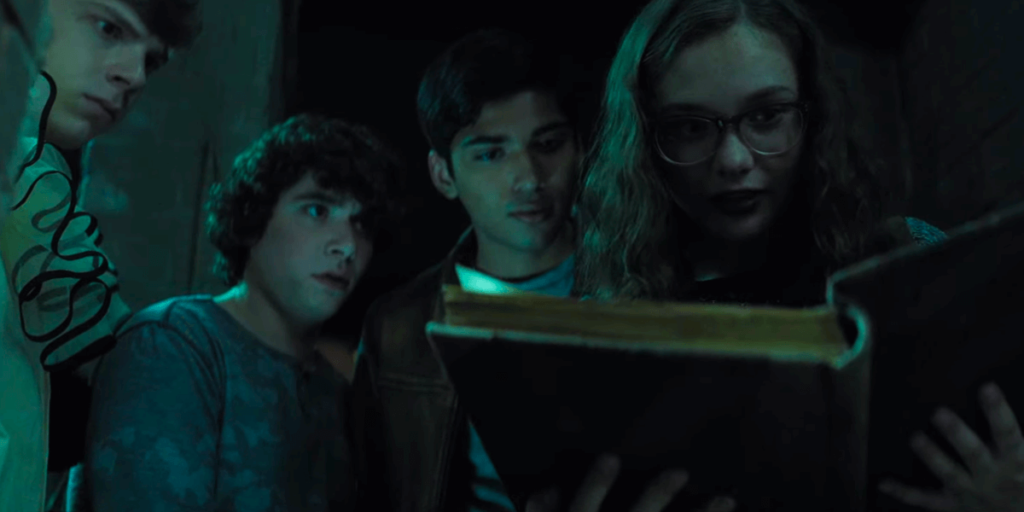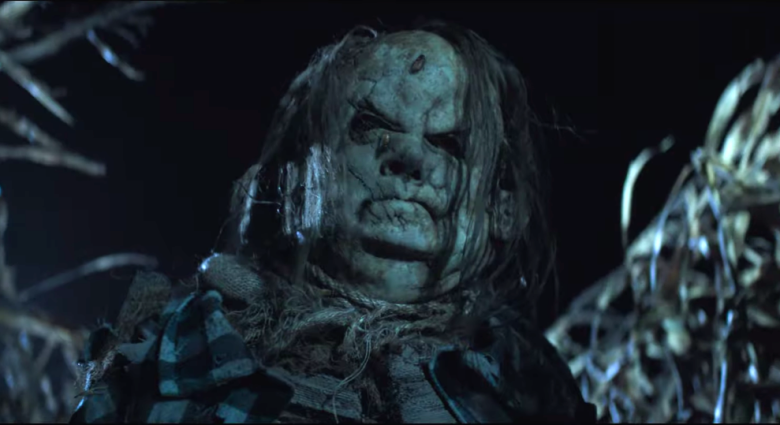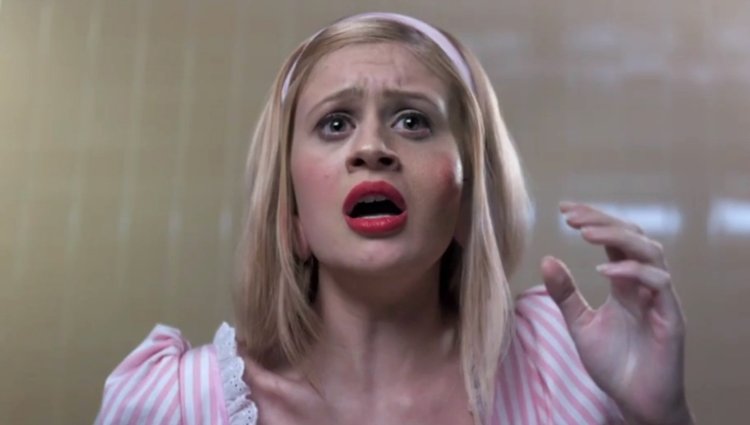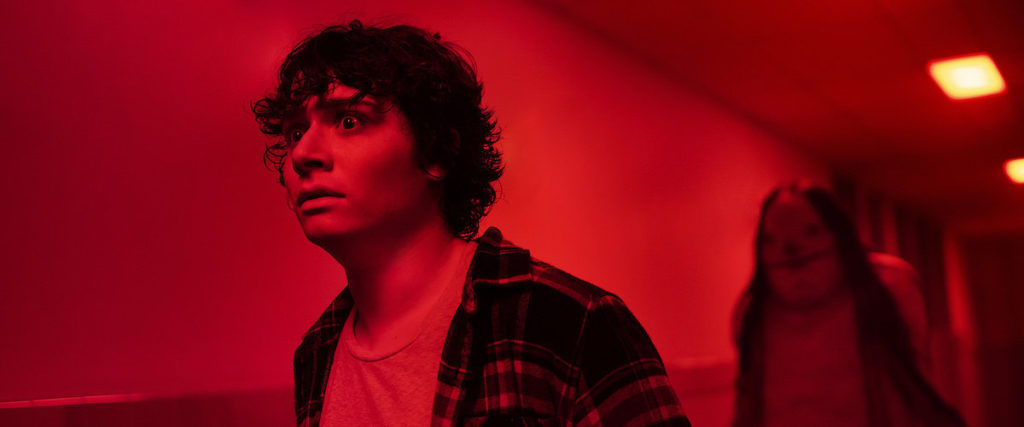
Less teenage horror movie than lightly creepy seminar, Scary Stories to Tell in the Dark functions as a kind of starter kit for curious viewers looking to dabble in the cinema of fright. Cogently threading together a handful of spooky tales lifted from Alvin Schwartz’s famous anthology of the same name, this passable imitator assembles the building blocks of classic fear fests, then nudges them into predictable, clockwork motion. It’s nothing we haven’t seen before, which may be why it seems geared toward horror virgins—the innocent few who really haven’t seen this stuff before. As an example of the genre, it’s pedestrian; as an introduction to it, it’s effective.
The director André Øvredal has a keen understanding of the essential elements, which he draws together with workmanlike efficiency. There is a haunted house, complete with creaky hinges, dark closets, and a cavernous basement. There is a cornfield, the rows upon ominous rows of crops lorded over by an ugly, unsmiling scarecrow. There are rusty wheelchairs, slowly turning doorknobs, and long, spindly shadows that emanate from nowhere, stretching menacingly across cobwebbed walls. And then there are the more visible and corporeal terrors: wriggling spiders; reanimated corpses; Richard Nixon.
That last ghastly sight comes courtesy of the film’s 1968 setting, which was presumably selected to enhance its homey, small-town bona fides. That sense of tight-knit community is crucial to Scary Stories, as one of its challenges is how to weave Schwartz’s titular tales—short, punchy yarns with ghoulish illustrations—into a traditional three-act narrative. The screenplay, which is credited to brothers Dan and Kevin Hageman, along with a rather successful fellow named Guillermo del Toro, accomplishes this with suitable ingenuity, concocting a cohesive plot involving a group of foolish young teens and the malevolent presence they stupidly, inadvertently awaken.

This conceit is fairly similar to the clown-based horror of It, and the parallels don’t end there; the movies’ conceptual approaches to fright are also comparable. Much like the evil Pennywise terrorized Stephen King’s youths by preying on their respective fears, Sarah Bellows, the nominal villain of Scary Stories, is a spectral presence capable of conjuring your darkest nightmares into deadly reality. The key difference is that, whereas It feverishly tried (and mostly failed) to flat-out petrify its audience, Scary Stories prefers to examine the inherent appeal of, well, scary stories. It isn’t so much visceral as intellectual; if it isn’t especially scary, that’s kind of the point.
And also kind of a letdown. Øvredal may have a solid grasp of the basics, but he doesn’t bring much flair to the proceedings. Instead, he dutifully lets scenes play out in their expected rhythm, which is both soothing and frustrating; you can appreciate the competent craft, but you may also want to flip through to the next chapter in the hopes of finding something more interesting.
To be fair, there are fleeting moments of inspiration. In one of the film’s quieter and more unsettling scenes, a boy hides in a dusty wardrobe, then opens the door to discover that the room has utterly transformed and now houses a veiled elderly woman and her unnervingly still dog. (Think Narnia, Hell Edition.) There’s also a clever sequence where the different body parts of a dismembered cadaver skitter across the floor to reassemble themselves, like a demented version of that classic scene in Terminator 2. For the most part, though, Øvredal adheres to the standard template: Kids find themselves trapped in dark places, creepy things show up, the music and the voices rise in pitch and intensity, and the targets of mayhem bloodlessly die or disappear.

This is not entirely a bad thing. There is pleasure in watching panicked individuals scramble to stave off their inevitable, supernaturally propelled demise, particular when the process involves quippy banter and desperate cunning. Our gang of hapless heroes here is led by Stella (Zoe Colletti, currently roughing it as Kevin Bacon’s daughter in City on a Hill), a bookish type with a fondness for Night of the Living Dead and a nose for trouble. On Halloween night, she and her two pals, the goofy Chuck (Austin Zajur) and the uptight Auggie (Gabriel Rush), decide to visit a haunted house; they’re joined by Ramón (Michael Garza), a handsome drifter who seems to be hiding a secret. Their destination is in fact the home of the aforementioned Sarah, the long-deceased heiress of the settlement’s pioneering family whose spirit is rumored never to have left. Following the usual mishaps and bad vibes—hissing wind, stubborn doors, the ole fake “Boo!”—they emerge with Sarah’s infamous book of (you guessed it) scary stories. The catch: New tales begin to appear, written in blood, which narrate events in real time, dispassionately describing various residents of this generic Pennsylvania town as they meet their sudden end.
What follows might be described as a cross between Tales from the Crypt and Final Destination. Scary Stories is decidedly not an anthology picture—the screenplay instead presents the escalating havoc as a noose continually tightening around Stella and her friends—but it nevertheless carries a sense of demarcation, with each of Sarah’s stories applying to a particular doomed character. The best of these is probably “The Big Toe”, which finds Auggie being stalked by a vengeful corpse missing a certain appendage; in addition to delivering the classic image of fingernails digging helplessly into floorboards, it allows Øvredal to play with forced perspective, plunging his camera downward as Auggie dives under his bed, straining his ears in the portentous silence. Other vignettes—one where a jerkish jock (Euphoria’s Austin Abrams) flees from that ungodly scarecrow, another where Chuck’s anxious sister (Natalie Ganzhorn) suffers a spider bite that inflames more than her skin—are solidly executed, if lacking in originality or surprise.

That Scary Stories attempts to dovetail these segments into a broader plot makes academic sense—as del Toro has put it, anthology films tend to be as bad as their worst segment—but it ends up backfiring. Stella and Ramón are the only two characters who receive any real development, and it serves them poorly; Stella—nicely played by Colletti, who evokes a steely vulnerability reminiscent of Abigail Breslin—totes a burdensome and clichéd backstory involving a grief-stricken father (Dean Norris) and a deserting mother, while a subplot surrounding Ramón’s draft-dodging is downright inexplicable. (Perhaps the script sought to analogize to the current traumas visited upon immigrants, but it doesn’t track.) And the final act, which flashes back to Sarah’s own torments at the hands of her cruel family, is muddy and stilted, a pale imitation of The Haunting of Hill House.
“You don’t read the book, the book reads you,” Stella says of Sarah’s tome of nightmares. That’s an unfortunate line of dialogue, but its placement in one of those obligatory exposition scenes—the kind where the characters gather around and fervently debate the underlying mythology—is revealing. After all, Scary Stories to Tell in the Dark is basically an instruction manual, priming viewers for their foray into horror as a genre, teaching them what to expect. In other words, you don’t watch this movie; this movie gives you notes.
Grade: C+
Jeremy Beck is the editor-in-chief of MovieManifesto. He watches more movies and television than he probably should.
